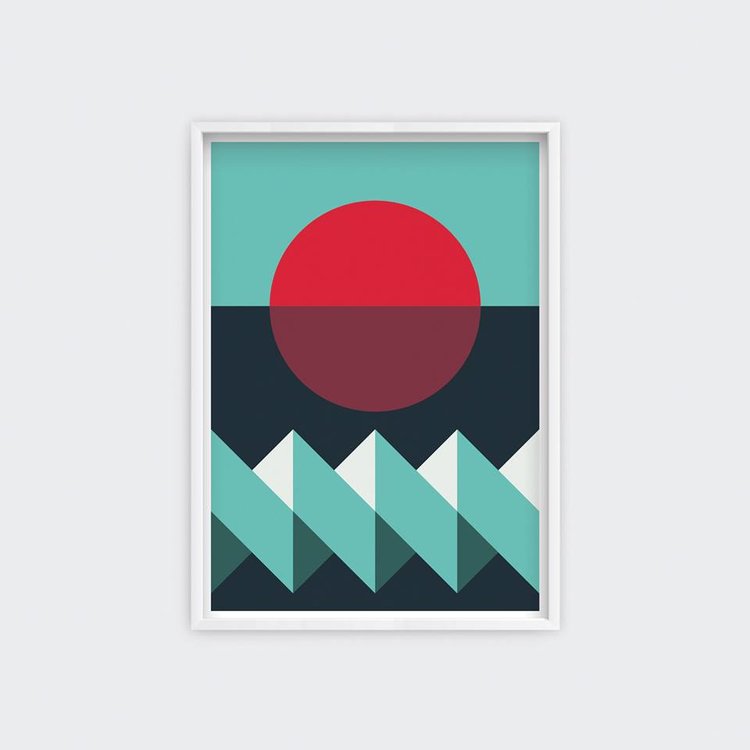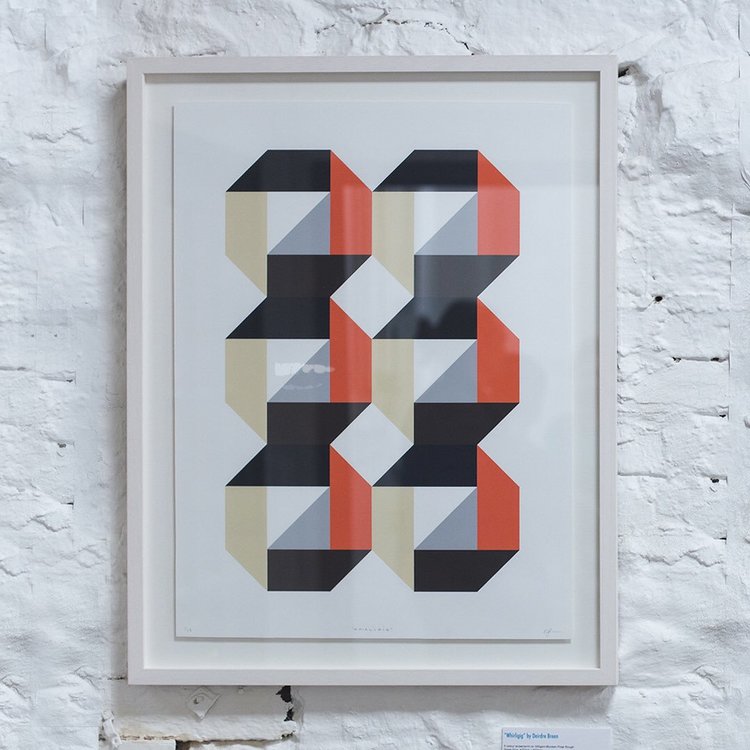
Deirdre Breen is a designer and printmaker based in Cork. With a background in Visual Communications from LSAD, Deirdre predominantly produces screen prints which play with abstract geometric forms, symmetrical compositions and colour theory. Her work has been exhibited in London and throughout Ireland and is also part of several private collections.

Where did you spend lockdown?
I spent the lockdown with my partner in our apartment in Cork City.
Did you have access to a studio during this time? If not, how did you continue to create work?
No. Unfortunately I didn’t have access to studio space. I’m currently undertaking an MA in Art & Process, and my studio space is in the Crawford’s Grand Parade campus. When the college closed, we had to take our materials and equipment home. Initially during the 2km limit, I was making work in our spare bedroom. It’s a small space but I managed to set it up in a way that I could continue working. I made a table out of the bed with sheets of MDF, and covered the floors so that I felt comfortable working with wet materials. The space doubled as an office so it did feel a bit claustrophobic at times. Since the movement restrictions have been lifted, I’ve moved the studio out to my parents house. My Mum has a studio space in their back garden which she’s kindly allowed me to use until I can get back into my studio space.

Can you talk me through your art making practice?
Up until recently, my work was concerned with the boundary between art and design, and compositional principles common to both. I was looking at colour theory and geometry, and ways I could manipulate these systems to create a series of abstracted structures and expressions of relational elements. I was exploring ways to simulate digital colour spaces in print, creating print editions by hand with a digital aesthetic, looking at the relationship between colour and form. Colour can appeal more directly and immediately to our emotions and strikes the eye before form. It can destroy or disorganise volume. Warm colours approach us, cool colours recess.
To create the compositions, I’ll often begin with photographs of buildings and architecture from places I’ve visited and observed. I’ll isolate and deconstruct elements of the image, identifying forms within structures and reducing them to their most simplest shapes. I’ll start sketching the shapes, playing with size and colour and exploring the interrelationships of these forms.
Generally, I’ll have themes set in mind for these exercises — repetition, gradation, contrast, radiation, concentration, volume and many others. Once I start to see something interesting happening, I’ll move onto the screen where I have more freedom and capacity for geometric compositions. I’ll loosely select colours before creating my stencils. Once I’m ready to start testing the colours I’ll move to the print studio. The process can vary depending on the print, but I find my colour decisions always change in the print studio. Forms can encounter one another in numerous ways, and I’ll begin by playing with how two or more shapes can relate to each other. I’ll look at colour distribution at the same time, observing how changes in colour can affect the relationship between any two shapes.
More recently I’ve been looking at design from a different angle, and exploring our relationship as humans to matter. My current research and practice raises questions about our place as embodied humans in the world and the ways we produce and consume our material environment, so before we went into lockdown I had started to consider ways I could begin to look at this in my studio practice.
Did you experiment with any new materials or methodologies?
Yes, I started working with moulds and casting. To-date a lot of my work has been in the medium of screen-printing. I didn’t have access to any studio print facilities so it forced me to explore new material processes. I started casting moulds in jesmonite who’s original forms were created by manipulating offcuts of foam. I also started to work with aluminium, making maquettes and sculptural pieces. I think the restrictions and the parameters have actually had a positive effect on my practice. It’s forced me to explore other mediums and be productive on a smaller scale.
Given the limitations and restrictions of the last few months, did your art making process change at all? If so, do you think this will continue to change how you will make art going forward?
A lot of my research at the moment is looking at the ways we produce, reproduce and consume our material environment. I’ve been exploring areas in and around Cork City where I can visibly see material flows at play. The lockdown meant that there were less people in the city, and a lot of businesses were closed. It was like a ghost town, but I found that when I did go out to walk it meant I was looking at my surroundings very differently, and noticing things I hadn’t noticed before. I got some great imagery of industrial sites which were pretty much empty at the time. I think the limitations have made me more resourceful with materials. I think this is something that will change my process.
Did you have any projects during this time that went ahead?
No I didn’t. The day the lockdown announcement was aired I was due to travel to Dublin for the opening of a group exhibition ‘Assemble’ in Atelier Maser. This was postponed and has been rescheduled to August 8th. There were other projects I was due to work on that were cancelled as they were part of larger festivals. I didn’t have any projects that could be moved online.
Do you have any other upcoming projects?
At the moment I’m focused on the MA, and as a group we’re working toward an end of year exhibition in November. It will be interesting to see how this develops, as nothing is certain in terms of restrictions for this time.
All photographs were provided by Deirdre Breen. To see more of Deirdre’s work visit her website and Instagram.
